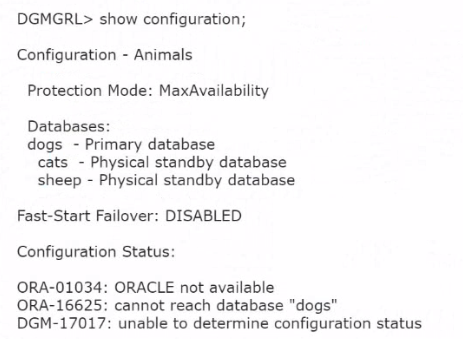Curious about Actual Oracle Database (1Z0-076) Exam Questions?
Here are sample Oracle Database 19c: Data Guard Administration (1Z0-076) Exam questions from real exam. You can get more Oracle Database (1Z0-076) Exam premium practice questions at TestInsights.
Which TWO are benefits of using Transaction Guard in a Data Guard environment?
Correct : B, D
Transaction Guard provides benefits in terms of transaction consistency and recovery in a Data Guard environment:
It provides application continuity by rolling back uncommitted transactions interrupted by a failover or switchover (B): Transaction Guard ensures that any uncommitted transactions at the time of an outage are rolled back consistently, thus preserving the integrity of the application's data and state.
It protects against recoverable errors during a planned or an unplanned outage of a primary database (D): Transaction Guard offers protection against errors that can occur during outages, allowing applications to resume operations more quickly and reliably after recovery. Reference:
Oracle Database High Availability Overview
Oracle Real Application Clusters Administration and Deployment Guide
Start a Discussions
Which THREE statements are true about Far Sync instances?
Correct : A, C, E
Far Sync instances are a feature of Oracle Data Guard designed to support zero data loss protection over long distances:
The Data Guard Broker must be used to deploy and manage Far Sync instances (A): Data Guard Broker simplifies the deployment and management of Far Sync instances, which are an integral part of zero data loss protection configurations.
They enable standby databases to be configured at remote distances from the primary without impacting performance on the primary (C): Far Sync instances are designed to receive redo from the primary database and then forward it to a remote standby database, thereby avoiding any performance impact on the primary database itself.
A primary database can ship redo directly to multiple Far Sync instances (E): A primary database can be configured to send redo logs to more than one Far Sync instance, which can then forward the redo to their respective remote standby databases. Reference:
Oracle Data Guard Concepts and Administration Guide
Oracle Database High Availability Overview
Start a Discussions
Which TWO statements are true about Real-Time Query?
Correct : A, C
Real-Time Query is a feature that allows queries to be run on a physical standby database while it is applying redo data. The relevant truths about it are:
Setting standby_max_data_delay=0 requires synchronous redo transport (A): For the real-time apply feature to function with no data delay (zero delay), synchronous redo transport must be used. This setting ensures that the data on the standby database is as current as possible before queries are executed against it.
Disabling Real-Time Query prevents the automatic start of redo apply when a physical standby database is opened read-only (C): If Real-Time Query is disabled, opening the standby database in read-only mode will not start the redo apply process automatically. Redo apply needs to be manually started to synchronize the standby database with the primary. Reference:
Oracle Data Guard Concepts and Administration Guide
Start a Discussions
Which TWO statements correctly describe the behavior of Automatic Block Media Recovery in a Data Guard environment, for a corrupt block in the example tablespace encountered by a session logged in as the SH user?
Correct : A, E
Automatic Block Media Recovery can be a significant feature for maintaining data integrity within a Data Guard configuration.
A corrupt block on the primary database can be automatically recovered, using a block from a standby database with Real-Time Query enabled (A): When a corrupted block is encountered on the primary database, Oracle can automatically replace it with a good block from the standby database where Real-Time Query is enabled, leveraging the standby as a source of good data.
A corrupt block on the primary database is automatically recovered, using a block from a flashback log from the primary database (E): If a good block version is available in the flashback logs of the primary database, Automatic Block Media Recovery can use it to recover the corrupted block on the primary. Reference:
Oracle Database Backup and Recovery User's Guide
Start a Discussions
Examine the Data Guard configuration:

Which three will be true after a successful failover to Cats?
Correct : B, D, E
After a successful failover to the 'cats' database in a Data Guard configuration:
B: Sheep, being another standby database, would typically remain in the enabled state unless specifically disabled or if there was a configuration issue.
D: Dogs, which was the primary database prior to failover, will be in a disabled state as part of the failover process. Manual intervention is required to re-establish 'dogs' as a standby database or to return it to the primary role through another role transition.
E: If the configuration was in Maximum Availability mode before failover, it would remain in this mode after failover, provided all settings were properly configured and no changes were made to the protection mode.
Option A is incorrect because failover does not automatically change the protection mode to Maximum Performance. The protection mode remains as it was prior to the failover unless manually altered.
Start a Discussions
Total 70 questions